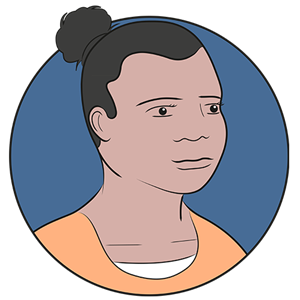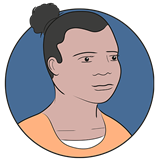Public health
Our vision for Aotearoa in 2040: Well-funded, effective public health system that keeps Aotearoa safe with Te Tiriti o Waitangi and equity at its heart
The public health system in Aotearoa NZ works at the top of the cliff to address the interwoven determinants of poor physical and mental health to ensure the health system can respond to the needs of our whānau and communities.
 Maria is 21, and lives in the suburbs of a large city.
Maria is 21, and lives in the suburbs of a large city.
She’s pregnant with her first child. She was working as a cleaner at a hotel
near the airport but lost her job once the pandemic hit and the borders closed. She met her partner David at work, where he worked in the restaurant. They had been together for a couple of months when Maria fell pregnant.
Both were nervous at the prospect of being parents — David was 20 and also lived at home. Maria was worried to tell her aunt and uncle about the baby, and she hadn’t thought how she might tell her Mum, who lives up north. She was anxious, feeling there was no right time to tell them.
Maria didn’t know how to get a midwife and she hadn’t yet registered with a GP. She couldn’t afford the $80 it was going to cost to transfer her health records from her GP in her home town. Maria hid her pregnancy until she was about 5 months along. Although her aunt and uncle were surprised, they agreed to support her.
"Me and David hadn’t been going out long when I fell pregnant… I think we were both scared and excited at the same time. I didn’t know how to tell my family. I felt like I had just moved here, I lost my job and suddenly I am going to be a Mum."
— Maria on her pregnancy
What is public health?
Although COVID-19 has highlighted the importance of having a functioning public health system for effective disease control, there are many other important factors that shape health in Aotearoa NZ. These include:
- urban design
- transport systems
- air quality
- the advertising of unhealthy food and alcohol
- tobacco regulation
- the impact of intensive farming practices
- water quality
- climate change
All have direct and indirect effects on individual, whānau, community and environmental health and wellbeing.
The emphasis in our system is currently on treating episodic personal illness, but this does not address the root causes of poor health. People will seek health care only to return to the same environments that made them unwell in the first place. Many whānau experience barriers to accessing healthcare — and if they do receive treatment, they are often left to navigate a complicated and hostile system which does little to affirm their right to quality, culturally safe and dignified healthcare.
The case for a public health agency for Aotearoa NZ
Public health functions are multidisciplinary and require a highly collaborative structure to achieve the best outcomes for our communities, where safe, healthy environments would be the norm. However, core public health functions in Aotearoa NZ are spread across multiple agencies, receive little profile or funding and have been left to languish by successive governments. This results in a system running in a series of silos where there is little coordination or oversight between activities.
Core public health functions in Aotearoa NZ
- Health protection
- Public health capacity development
- Assessment and surveillance
- Preventative interventions
- Health promotion
"Population health leadership, functions, and accountabilities must be designed and delivered in a way that is coherent, coordinated and agile"
Interim report of the Health and Disability System Review
A model for interconnection and equity
A public health agency would gather together all the groups responsible for the five core functions of public health:
- preventative programs like immunisation
- health promotion around high-risk products like alcohol
- protection from new hazards
- information on health determinants and status
- how the system can improve to support enhanced public health
The interdependency of these functions would be supported by a single public health entity that would be responsible for governance and oversight of the system. Te Whare Tapa Wha is a Māori model of total health and wellbeing which also depicts the inter-connectedness and relationship between components that when in balance, constitute Hauora — total health and wellbeing. Illness arises when one side is disconnected, weakened or out of balance.
- Taha tinana — physical health and bodily wellbeing
- Taha whānau — family and whānau health
- Taha hinengaro — mental health and wellbeing
- Taha wairua — spiritual health
- Taha whenua — the health of the land and environment
It is time to re-imagine public health in Aotearoa NZ and establish a model that is integrated, connected and funded to protect and promote health and wellbeing for all. It must be a national priority to ensure that access to public health services and infrastructure is equitable, and this should not be dependent on which District Health Board people reside in.
Essential infrastructure
A public health agency would also inform the provision of key infrastructure we know makes a big difference to health
outcomes, for example systems like contact tracing, which is critical to prevent the spread of infectious diseases were well
below capacity prior to the arrival of COVID-19. Aotearoa NZ’s public health system has been inadequate and poorly
responsive to control of other infectious diseases with increases in rates of sexually transmitted infections (notably gonorrhoea
and syphilis) in recent years and the 2019 Measles outbreak.
‘Health literacy’ creates barriers
Health promotion and education can only be effective if it is reinforced by other aspects of the system that are informed by evidence and the needs of our communities. Health promotion should be driven by aims of equitable outcomes, rather than
increasing population ‘health literacy’. Assumed attributes like health literacy are reinforced by a health system which is
designed to reflect the overtly clinical, individualised expectations of the mainstream.
Health literacy implies that only those who have acquired the skills to interpret the system should be able to access it — an
acknowledgement that bias is inbuilt.
 Maria had no contact with maternity services until she was around 25 weeks pregnant. She felt shy and embarrassed, particularly at some of the questions she was asked. She didn’t want the midwife to think she would be a bad parent.
Maria had no contact with maternity services until she was around 25 weeks pregnant. She felt shy and embarrassed, particularly at some of the questions she was asked. She didn’t want the midwife to think she would be a bad parent.
Maria’s midwife asked her to get blood tests as part of routine pregnancy screening, but she did not go into any detail about what the tests were for, and if a positive result would mean anything for her and her baby. Maria had the blood test, and when she didn’t hear anything, she assumed both she and her baby were fine.
"I went to see the midwife. I didn’t know what to expect and I was shy.
She told me to get blood tests but she also said that baby was growing well, and I said I was feeling ok, no morning sickness or anything.
She said I should have been taking a pill (folic acid) to prevent birth
defects and it was too late for me to start. I felt so stupid and ashamed for not making an appointment so."
Maria felt judged by the midwife for not making an appointment earlier and she went in to labour, earlier than expected, at 31 weeks. David was able to call his brother to drive them to the hospital. Maria and David’s baby boy was stillborn. He had contracted syphilis in the womb. The routine pregnancy blood test Maria had was positive for syphilis.
The laboratory informed the Public Health Unit, who tried to contact Maria but the call came up as a 'private number' and she didn’t answer — it could be Baycorp. Maria was paying off a payday loan she had taken out the year before. The interest was high and she was worried about debt collectors.
Preventable infectious diseases can be eliminated
Aotearoa NZ can eliminate many infectious diseases if the system is resourced and operates with health equity at its heart.
As a result of the COVID-19 pandemic, capacity in public health systems for contact tracing was found to be inadequate for
a large outbreak and was quickly scaled to ensure the system was robust. The same energy and resource must be applied to
preventable infectious diseases which are heavily influenced by poverty and deprivation.
Potentially devastating health conditions like rheumatic fever and rheumatic heart disease, as well as vaccine-preventable
conditions like measles could be avoided if sustained resourcing for sore throat clinics and immunisation drives were
prioritised as part of preventable public health actions. Although many sexually transmitted infections can be treated easily
with antibiotics, many factors including stigma and lack of access to health services means the risk of serious consequences
such as congenital syphilis is increased.
What would have made a difference?
Congenital syphilis should not be a reality for whānau in Aotearoa NZ: Cuba and Malaysia have both eliminated congenital
syphilis. Since 2016, Aotearoa NZ has recorded 14 confirmed cases of congenital syphilis, including 6 stillbirths. Aotearoa NZ can eliminate congenital syphilis through public health leadership, including:
Contact tracing
Improvements made to our contact tracing capacity and capability must be retained to support public health interventions for
COVID-19 and other notifiable infectious diseases including syphilis. The contact tracing methodology should be acceptable
to patients and should uphold privacy while not creating additional barriers in terms of accessibility as trust is vital for this to
be effective.
Culturally safe workforce
Cultural safety acknowledges the power imbalances and biases within the system and that these are inbuilt through
systems, structures, processes and people to reflect and reinforce dominant narratives and approaches to health and wellbeing.
All functions of the health system must be supported by a culturally safe, skilled workforce. This includes the public health
workforce responsible for the design and implement of population-level strategies and policies, which in turn shape how
public health functions in daily life.
Action on the social determinants of health
Infrastructure and people can only support improved outcomes if the settings are right to start with. Addressing low
household incomes, insecure work, poor housing, racism, food insecurity and access to healthcare is the foundation to
support equity in public health.